Performance Analysis of Pile Group Installation in Saturated Clay
Abstract
:1. Introduction
2. Numerical Modeling and Validation
2.1. Single Pile Installation Model
2.2. Model Validation
3. Two-Pile Group Analyses
3.1. Displacement of Adjacent Pile
3.1.1. Lateral Displacement
3.1.2. Vertical Displacement
3.2. Internal Forces of Adjacent Pile
3.3. Vertical Bearing Capacity of Adjacent Pile
4. Conclusions
Author Contributions
Funding
Institutional Review Board Statement
Informed Consent Statement
Data Availability Statement
Conflicts of Interest
References
- Yang, J.; Tham, L.G.; Lee, P.K.K.; Chan, S.T.; Yu, F. Behaviour of jacked and driven piles in sandy soil. Géotechnique 2006, 56, 245–259. [Google Scholar] [CrossRef]
- Gong, W.; Li, J.; Li, L.; Zhang, S. Evolution of mechanical properties of soils subsequent to a pile jacked in natural saturated clays. Ocean. Eng. 2017, 136, 209–217. [Google Scholar] [CrossRef]
- Pestana, J.M.; Hunt, C.E.; Bray, J.D. Soil deformation and excess pore pressure field around a closed-ended pile. J. Geotech. Geoenviron. Eng. 2002, 128, 1–12. [Google Scholar] [CrossRef]
- Li, X.; Cai, G.; Liu, S.; Puppala, A.J.; Zheng, J.; Jiang, T. Undrained shear strength and pore pressure changes due to prestress concrete pile installation in soft clay. Int. J. Civ. Eng. 2019, 17, 193–203. [Google Scholar] [CrossRef]
- Hoang, L.T.; Dao, K.X.; Xiong, X.; Matsumoto, T. Performance analysis of a jacked-in single pile and pile group in saturated clay ground. Soils Found. 2022, 62, 101094. [Google Scholar] [CrossRef]
- Li, Y.N.; Li, J.P.; Zhang, S.T. Model Test Research on the Compaction Effect of Jacked Pile in Layered Soil. In Deep Foundations and Geotechnical In Situ Testing, Proceedings of GeoShanghai 2010; ASCE Press: Reston, VA, USA, 2010; pp. 238–245. [Google Scholar]
- Luo, Z.; Tao, Y.; Gong, X.; Zou, B. Soil compacting displacements for two jacked piles considering shielding effects. Acta Geotech. 2020, 15, 2367–2377. [Google Scholar] [CrossRef]
- Le Kouby, A.; Dupla, J.C.; Canou, J.; Francis, R. The effects of installation order on the response of a pile group in silica sand. Soils Found. 2016, 56, 174–188. [Google Scholar] [CrossRef]
- Cooke, R.W.; Price, G.; Tarr, K. Jacked piles in London Clay: A study of load transfer and settlement under working conditions. Geotechnique 1979, 29, 113–147. [Google Scholar] [CrossRef]
- Foglia, A.; Abdel-Rahman, K.; Wisotzki, E.; Quiroz, T.; Achmus, M. Large-scale model tests of a single pile and two-pile groups for an offshore platform in sand. Can. Geotech. J. 2021, 99, 1825–1838. [Google Scholar] [CrossRef]
- Bishop, R.F.; Hill, R.; Mott, N.F. The theory of indentation and hardness tests. Proc. Phys. Soc. 1945, 57, 147–159. [Google Scholar] [CrossRef]
- Vesić, A.S. Expansion of cavities in infinite soil mass. J. Soil Mech. Found. Div. 1972, 98, 265–290. [Google Scholar] [CrossRef]
- Carter, J.P.; Booker, J.R.; Yeung, S.K. Cavity expansion in cohesive frictional soils. Geotechnique 1986, 36, 349–358. [Google Scholar] [CrossRef]
- Chen, S.L.; Abousleiman, Y.N. Exact undrained elasto-plastic solution for cylindrical cavity expansion in modified Cam Clay soil. Géotechnique 2012, 62, 447–456. [Google Scholar] [CrossRef]
- Castro, J.; Sivasithamparam, N. Theoretical solution for drained cylindrical cavity expansion in clays with fabric anisotropy and structure. Acta Geotech. 2022, 17, 1917–1933. [Google Scholar] [CrossRef]
- Cui, J.; Rao, P.; Li, J.; Chen, Q.; Nimbalkar, S. Time-dependent evolution of bearing capacity of driven piles in clays. Proc. Inst. Civ. Eng. Geotech. Eng. 2022, 176, 402–418. [Google Scholar] [CrossRef]
- Poulos, H.G. Effect of pile driving on adjacent piles in clay. Can. Geotech. J. 1994, 31, 856–867. [Google Scholar] [CrossRef]
- Zhou, P.; Zhou, H.; Liu, H.; Li, X.; Ding, X.; Wang, Z. Analysis of lateral response of existing single pile caused by penetration of adjacent pile in undrained clay. Comput. Geotech. 2020, 126, 103736. [Google Scholar] [CrossRef]
- Zhou, P.; Li, J.; Li, L.; Xie, F. Analysis of the existing pile response induced by adjacent pile driving in undrained clay. Comput. Geotech. 2021, 138, 104319. [Google Scholar] [CrossRef]
- Sharif, Y.U.; Brown, M.J.; Ciantia, M.O.; Cerfontaine, B.; Davidson, C.; Knappett, J.; Meijer, G.J.; Ball, J. Using discrete element method (DEM) to create a cone penetration test (CPT)-based method to estimate the installation requirements of rotary-installed piles in sand. Can. Geotech. J. 2021, 58, 919–935. [Google Scholar] [CrossRef]
- Su, D.; Wu, Z.; Lei, G.; Zhu, M. Numerical study on the installation effect of a jacked pile in sands on the pile vertical bearing capacities. Comput. Geotech. 2022, 145, 104690. [Google Scholar] [CrossRef]
- Cerfontaine, B.; Ciantia, M.O.; Brown, M.J.; White, D.J.; Sharif, Y.U. DEM study of particle scale effect on plain and rotary jacked pile behaviour in granular materials. Comput. Geotech. 2023, 161, 105559. [Google Scholar] [CrossRef]
- Cheng, X.; Vanapalli, S.K. Prediction of the end-bearing capacity of axially loaded piles in saturated and unsaturated soils based on the stress characteristics method. Int. J. Geomech. 2023, 23, 04023104. [Google Scholar] [CrossRef]
- Kang, C.; Yi, J. Large Deformation Numerical Simulation of the Set up Effect Induced by Sand Compaction Pile Group Installation. In MATEC Web of Conferences; EDP Sciences: Les Ulis, France, 2020; Volume 319, p. 06003. [Google Scholar]
- Yi, J.T.; Liu, F.; Zhang, T.B.; Yao, K.; Zhen, G. A large deformation finite element investigation of pile group installations with consideration of intervening consolidation. Appl. Ocean. Res. 2021, 112, 102698. [Google Scholar] [CrossRef]
- Tho, K.K.; Chen, Z.; Leung, C.F.; Chow, Y.K. Enhanced analysis of pile flexural behavior due to installation of adjacent pile. Can. Geotech. J. 2014, 51, 705–711. [Google Scholar] [CrossRef]
- Jayasinghe, L.B.; Waldmann, D.; Shang, J. Impact of pile punching on adjacent piles: Insights from a 3D coupled SPH-FEM analysis. Appl. Mech. 2020, 1, 47–58. [Google Scholar] [CrossRef]
- Zhou, P.; Liu, H.; Zhou, H.; Cao, G.; Ding, X. A simplified analysis approach for the effect of the installation of adjacent XCC pile on the existing single XCC pile in undrained clay. Acta Geotech. 2022, 17, 5499–5519. [Google Scholar] [CrossRef]
- Dong, J.; Chen, F.; Zhou, M.; Zhou, X. Numerical analysis of the boundary effect in model tests for single pile under lateral load. Bull. Eng. Geol. Environ. 2018, 77, 1057–1068. [Google Scholar] [CrossRef]
- Carter, J.P.; Randolph, M.F.; Wroth, C.P. Stress and pore pressure changes in clay during and after the expansion of a cylindrical cavity. Int. J. Numer. Anal. Methods Geomech. 1979, 3, 305–322. [Google Scholar] [CrossRef]
- Henke, S.; Grabe, J. Simulation of pile driving by 3-dimensional Finite-Element analysis. In Proceedings of the 17th European Young Geotechnical Engineers’ Conference, Zagreb, Crotia, 19–23 July 2006; pp. 215–233. [Google Scholar]
- Konkol, J.; Bałachowski, L. Large deformation finite element analysis of undrained pile installation. Stud. Geotech. Mech. 2016, 38, 45–54. [Google Scholar] [CrossRef]
- Li, L.; Li, J.; Sun, D.A.; Gong, W. Analysis of time-dependent bearing capacity of a driven pile in clayey soils by total stress method. Int. J. Geomech. 2017, 17, 04016156. [Google Scholar] [CrossRef]
- Sabetamal, H.; Nazem, M.; Carter, J.P.; Sloan, S.W. Large deformation dynamic analysis of saturated porous media with applications to penetration problems. Comput. Geotech. 2014, 55, 117–131. [Google Scholar] [CrossRef]
- Yang, Z.X.; Gao, Y.Y.; Jardine, R.J.; Guo, W.B.; Wang, D. Large deformation finite-element simulation of displacement-pile installation experiments in sand. J. Geotech. Geoenviron. Eng. 2020, 146, 04020044. [Google Scholar] [CrossRef]
- Gue, S.; Gue, S.S. Ground Heave Around Driven Piles in Clay. Ph.D. Thesis, University of Oxford, Oxford, UK, 1984. [Google Scholar]
- Hwang, J.H.; Liang, N.; Chen, C.H. Ground response during pile driving. J. Geotech. Geoenviron. Eng. 2001, 127, 939–949. [Google Scholar] [CrossRef]
- Bjerrum, L.; Johannessen, I.J. Pore Pressures Resulting from Driving Piles in Soft Clay; Norwegian Geotechnical Institute: London, UK, 1961; pp. 108–111. [Google Scholar]
- Konkol, J.; Bałachowski, L. Influence of installation effects on pile bearing capacity in cohesive soils–large deformation analysis via Finite Element Method. Stud. Geotech. Mech. 2017, 39, 27–38. [Google Scholar] [CrossRef]
- Wersäll, C.; Massarsch, K.R. Soil heave due to pile driving in clay. In Sound Geotechnical Research to Practice: Honoring Robert D. Holtz II, Proceedings of Geo-Congress 2013; ASCE Press: Reston, VA, USA, 2013; pp. 480–498. [Google Scholar]
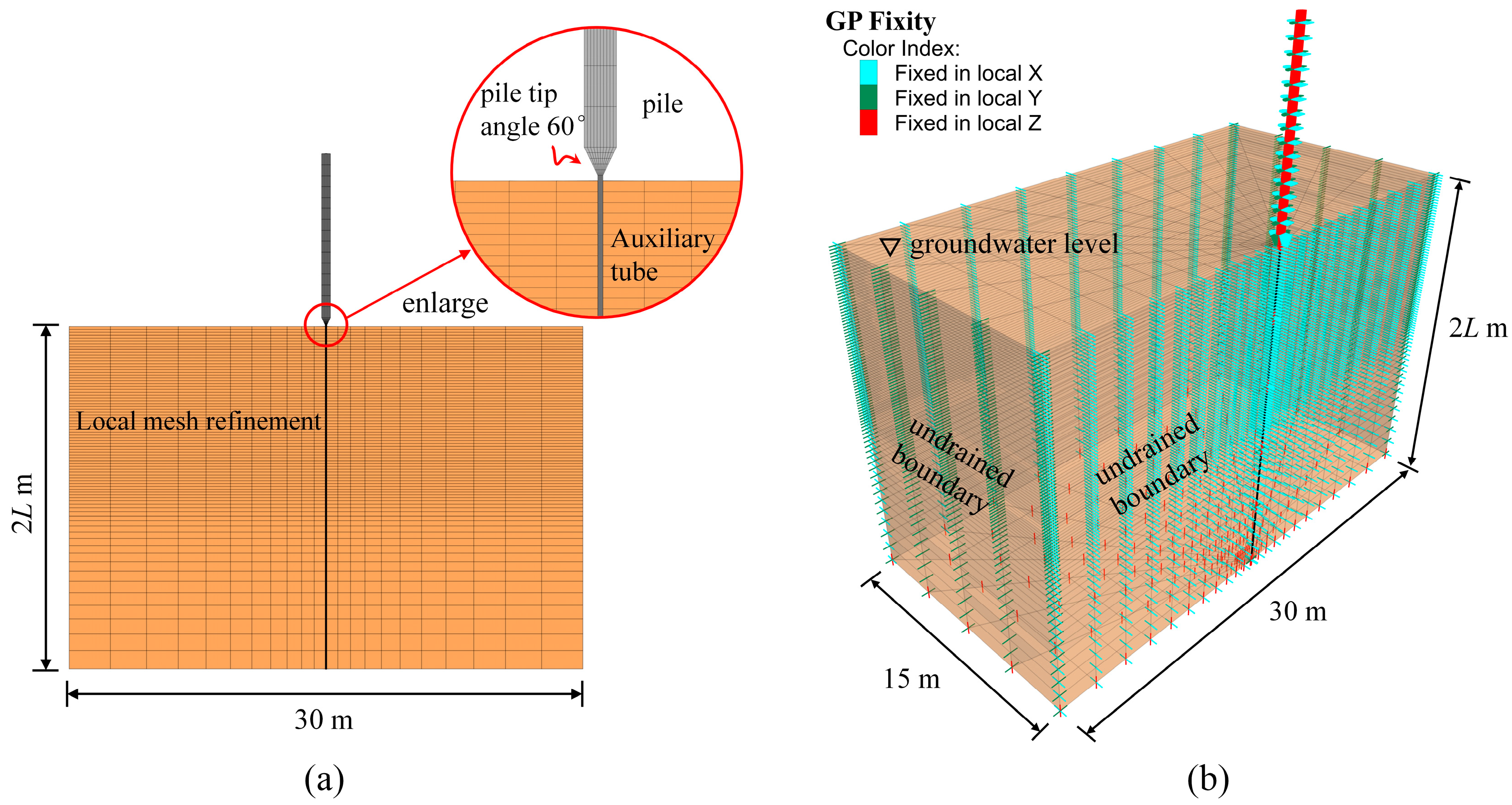
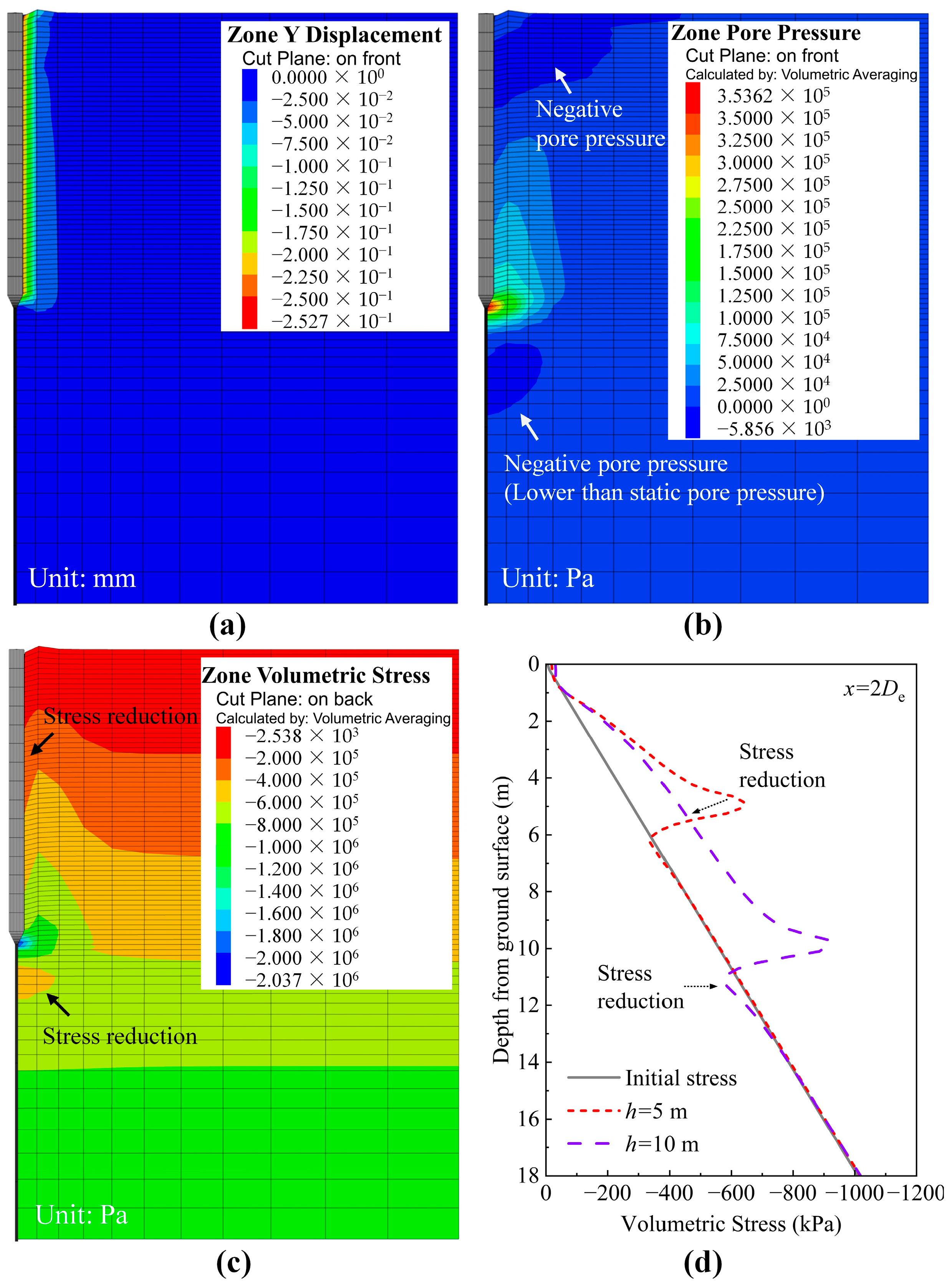
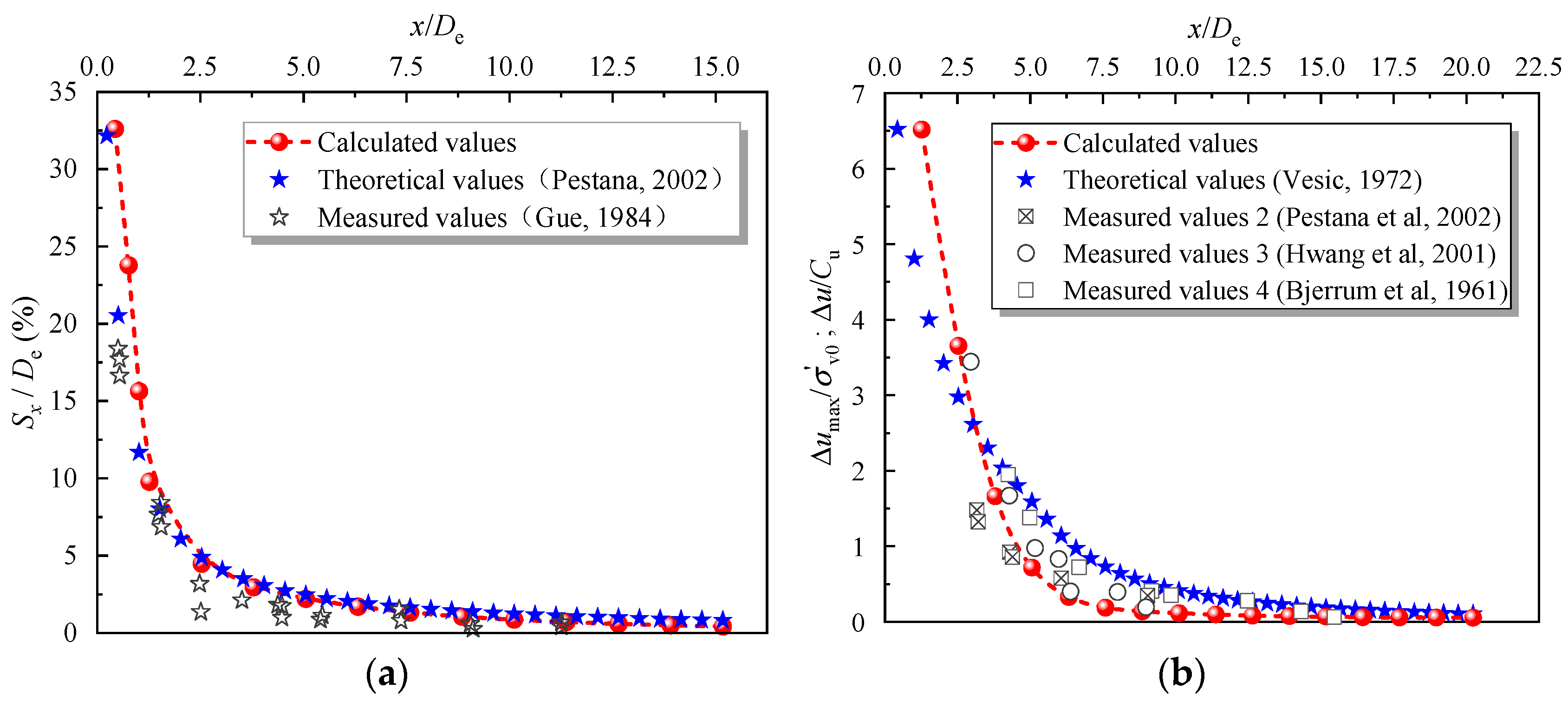
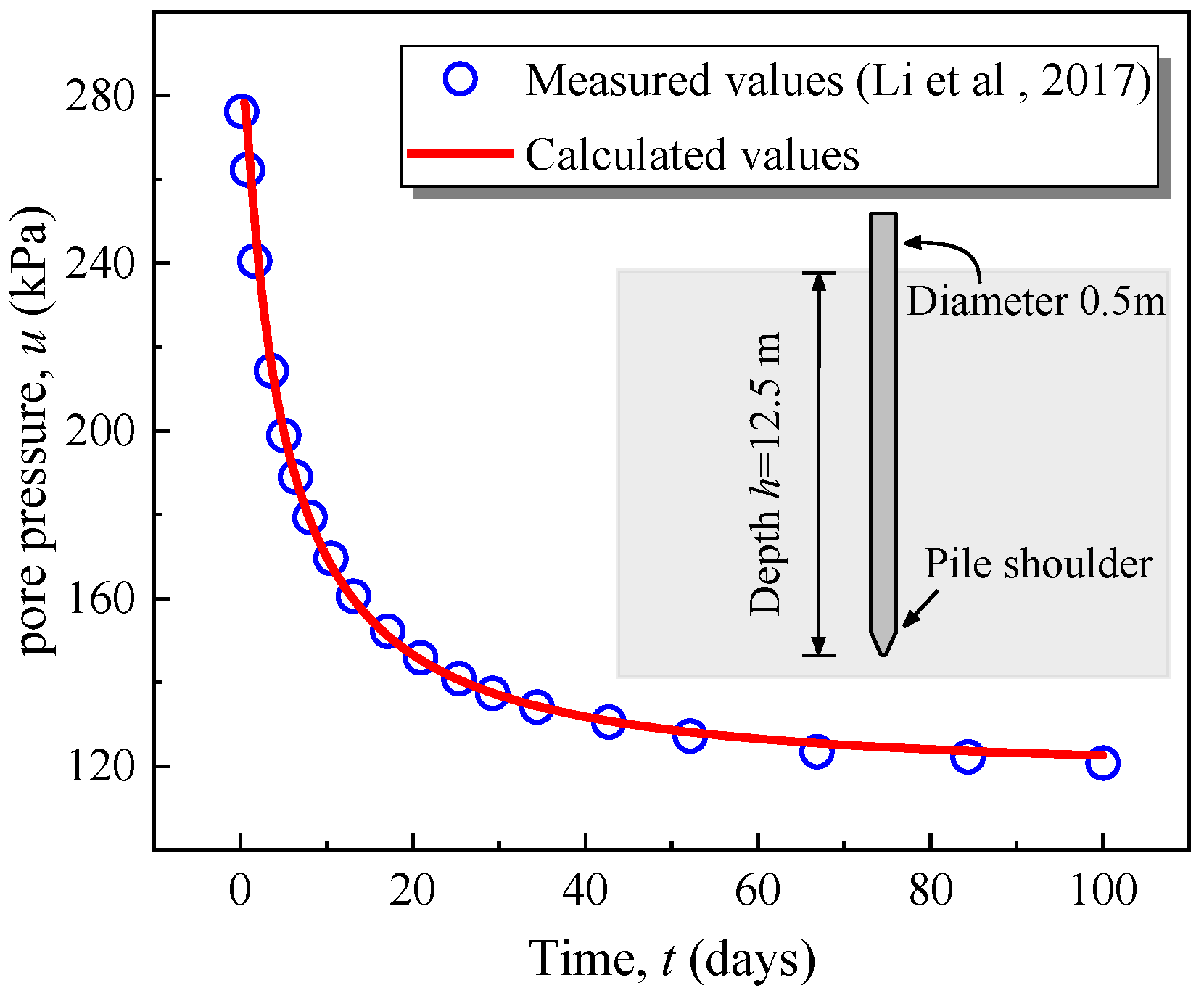
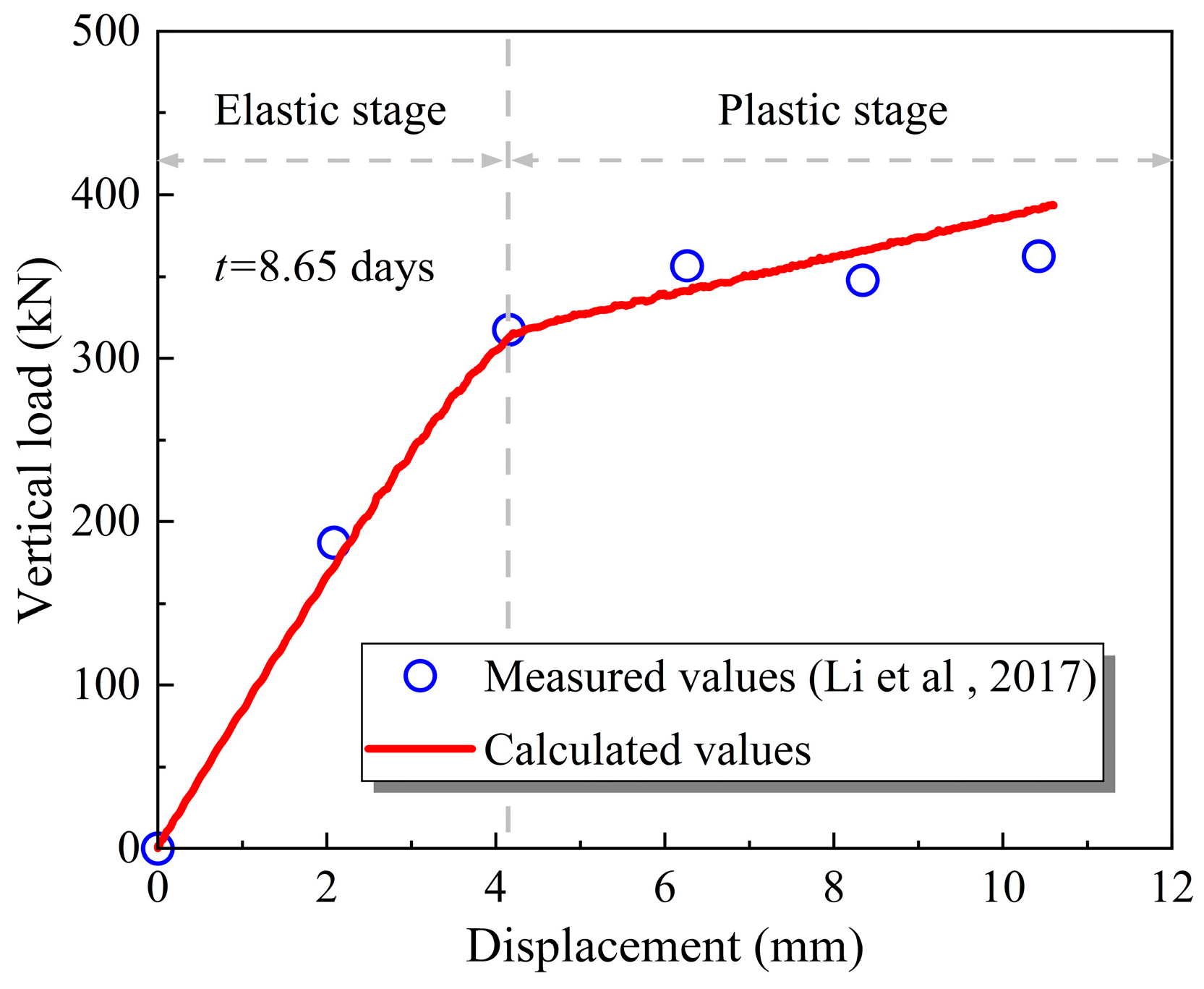
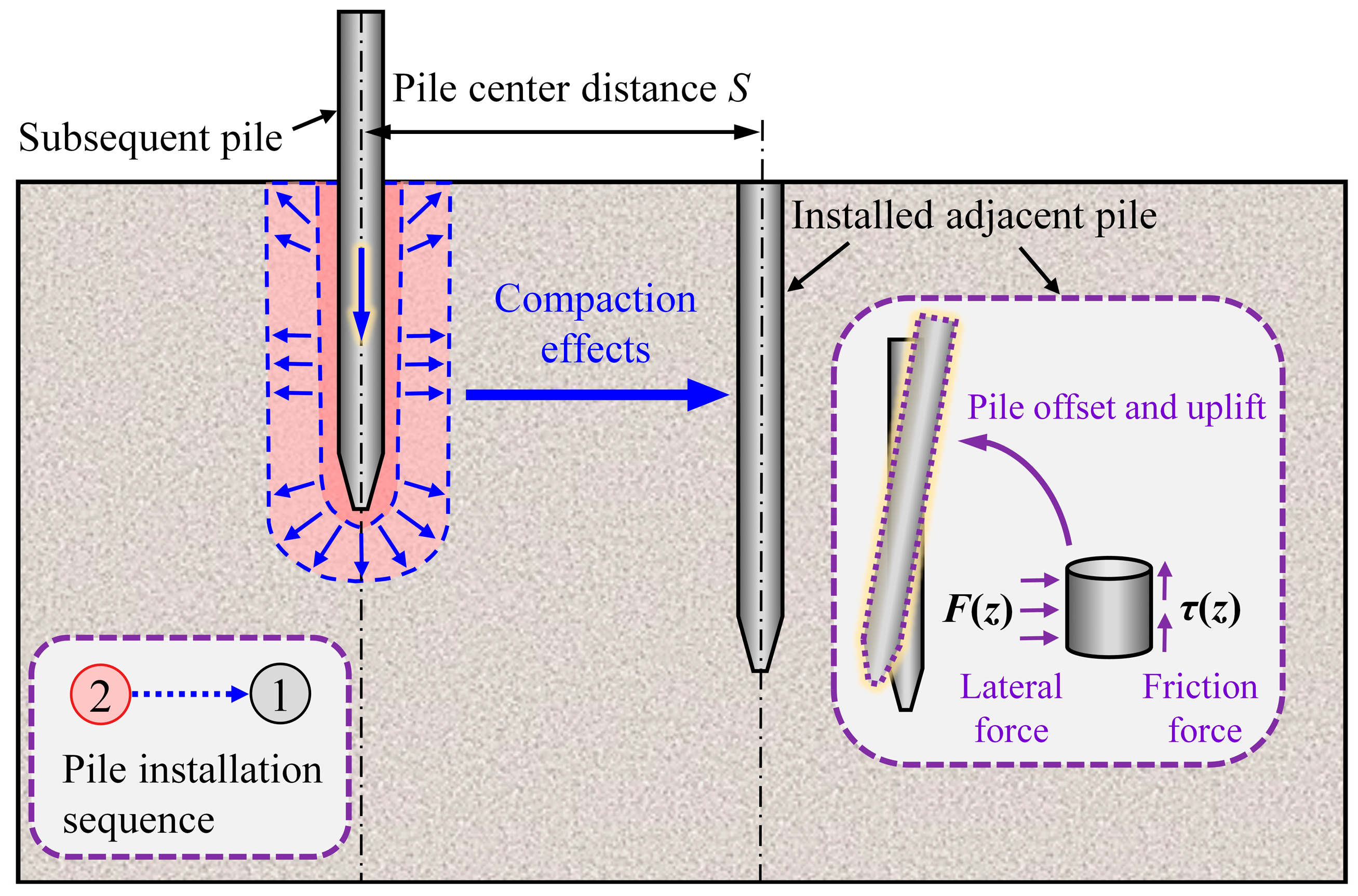

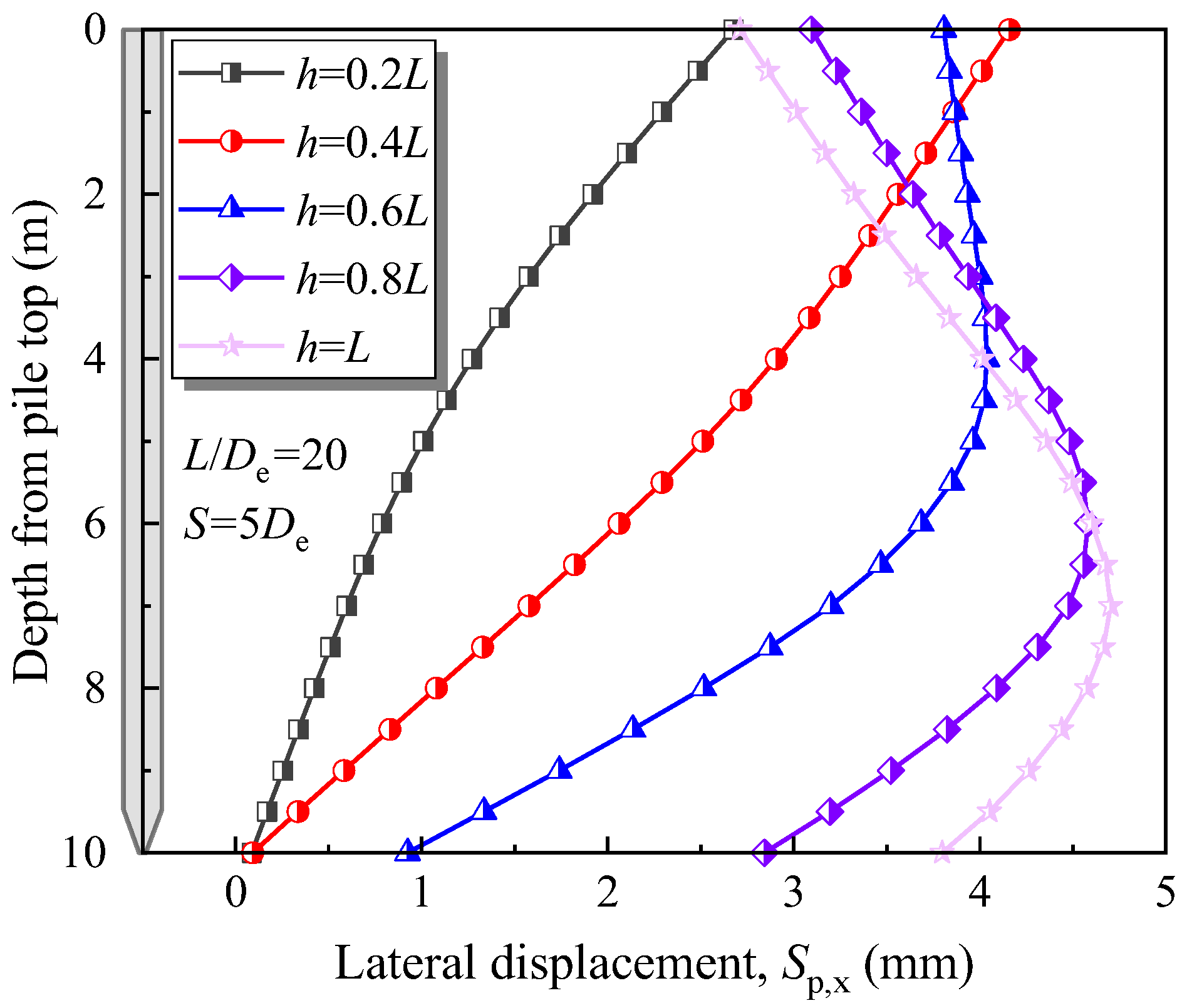


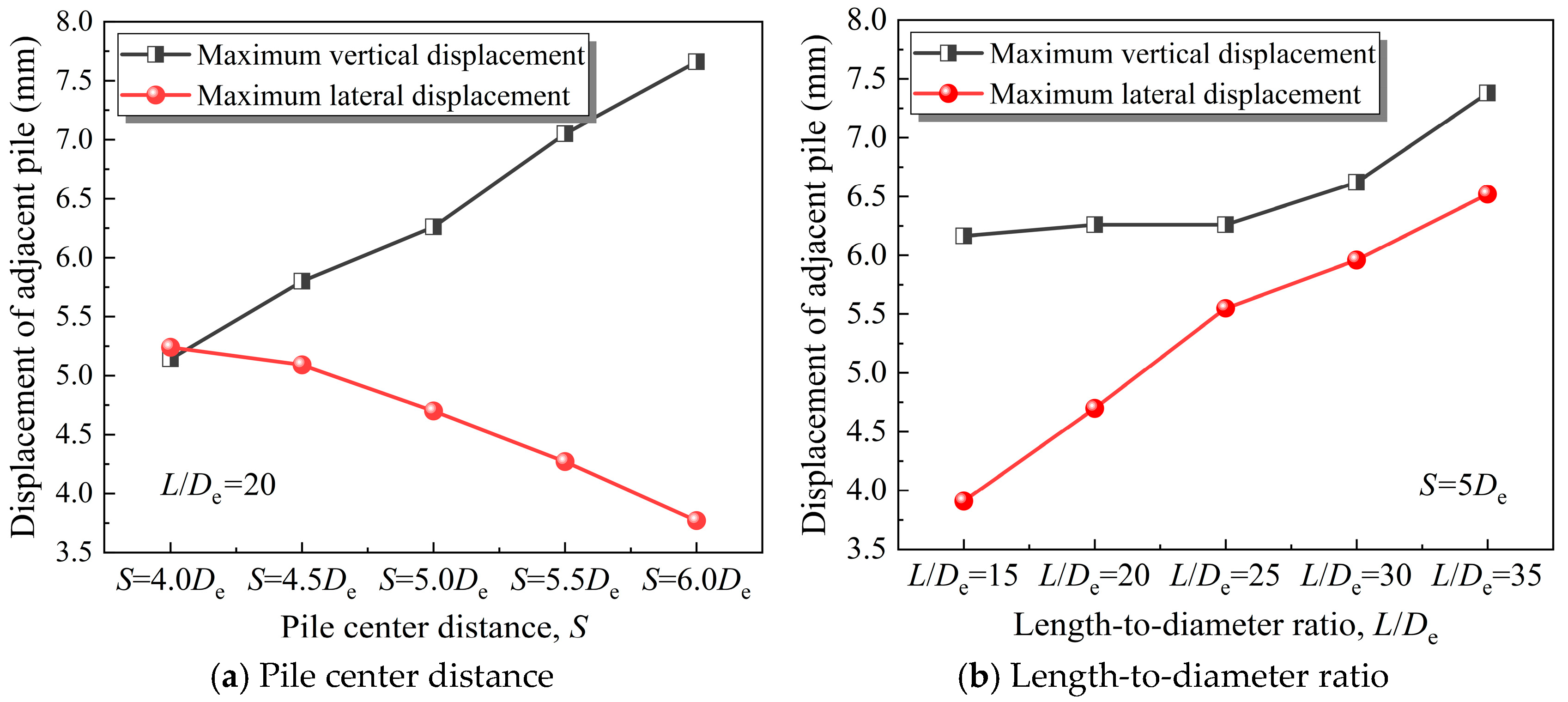



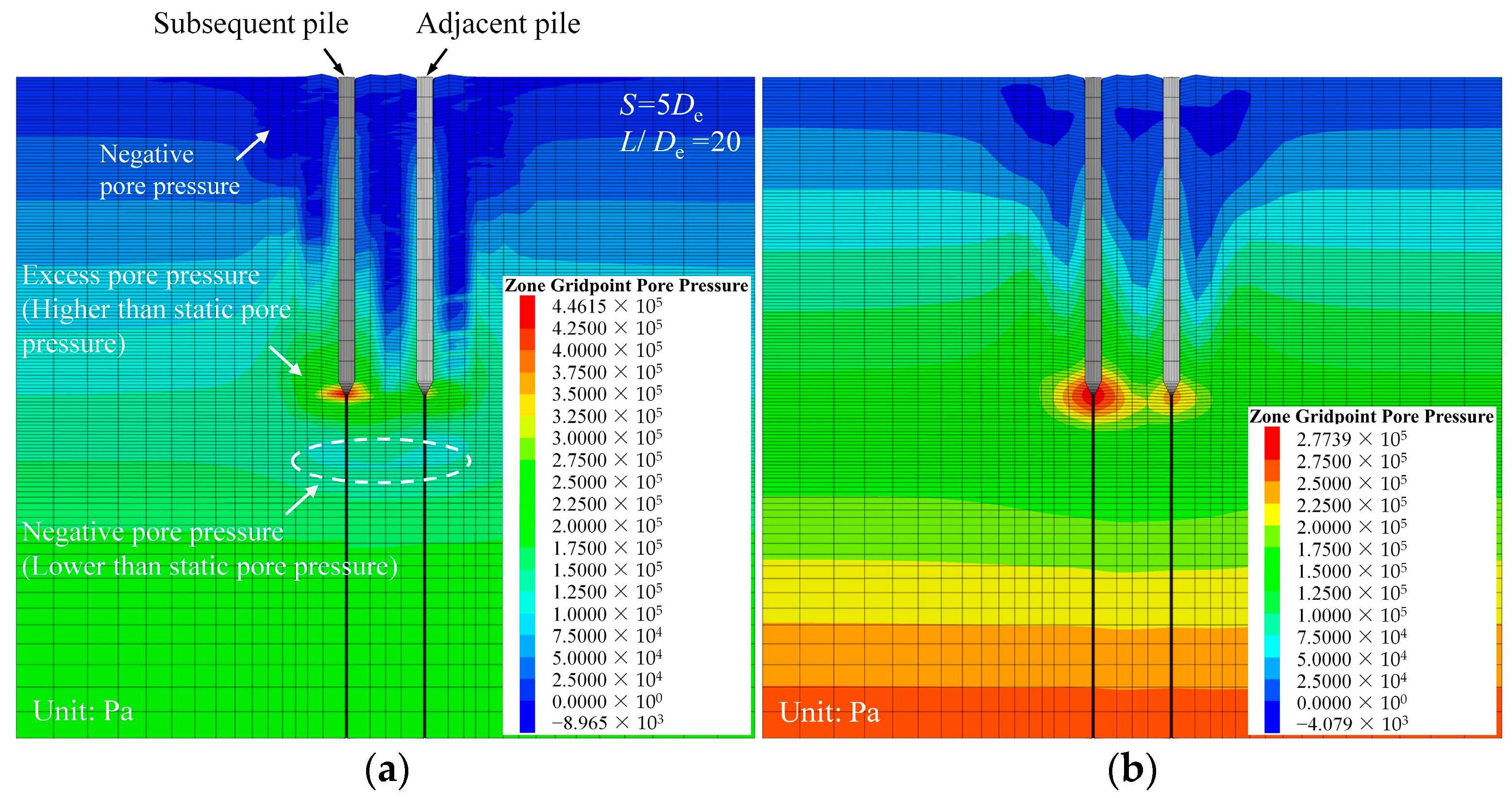
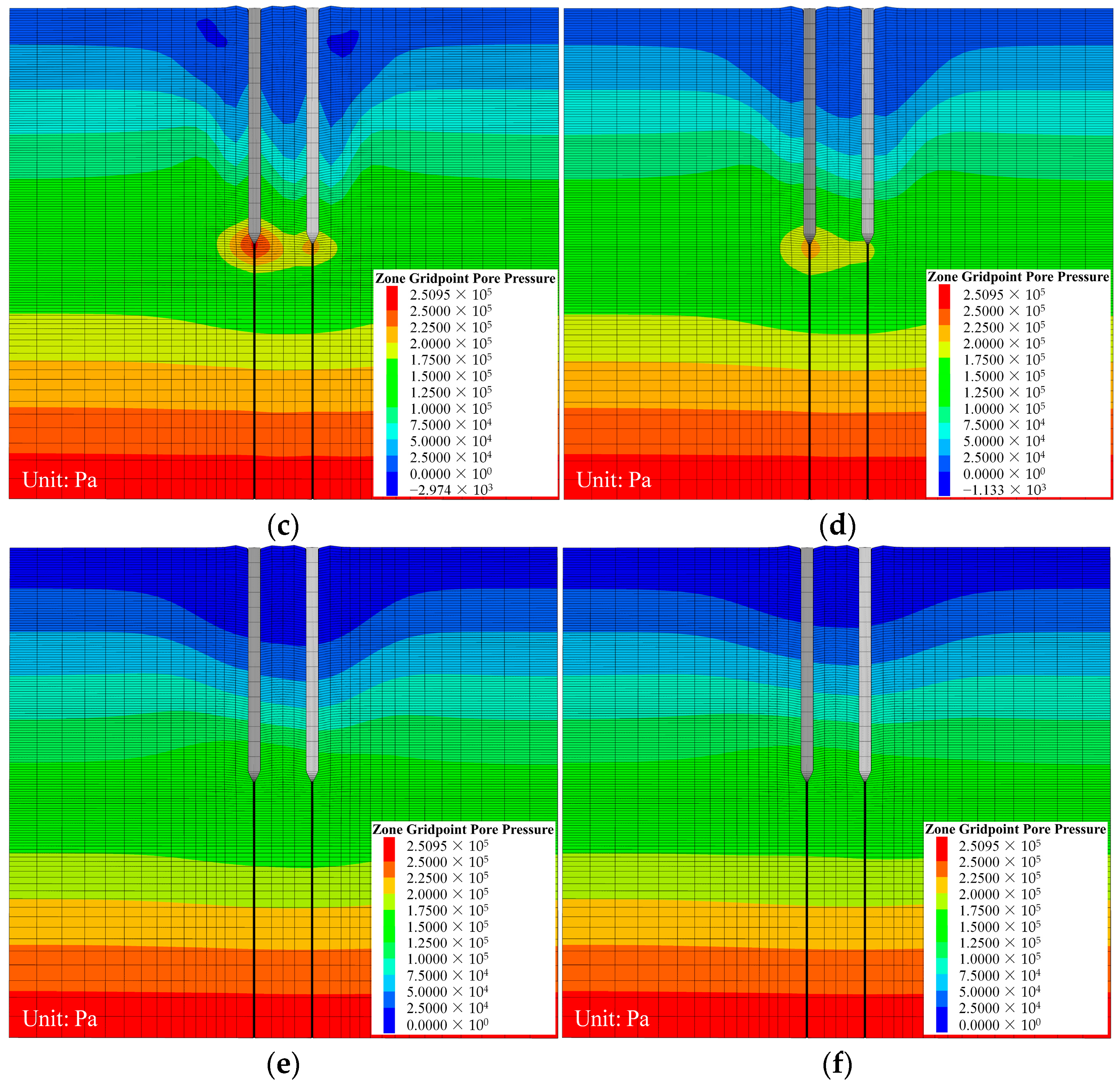
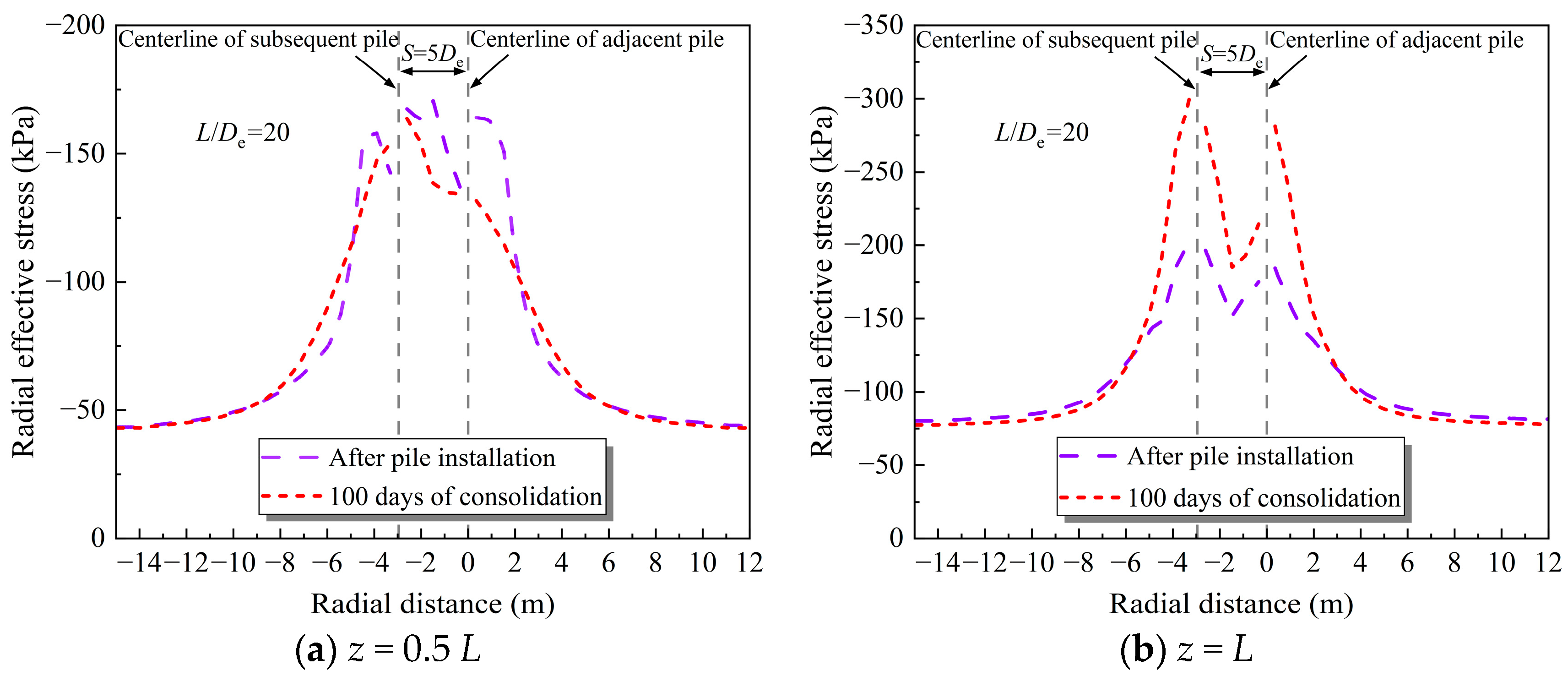
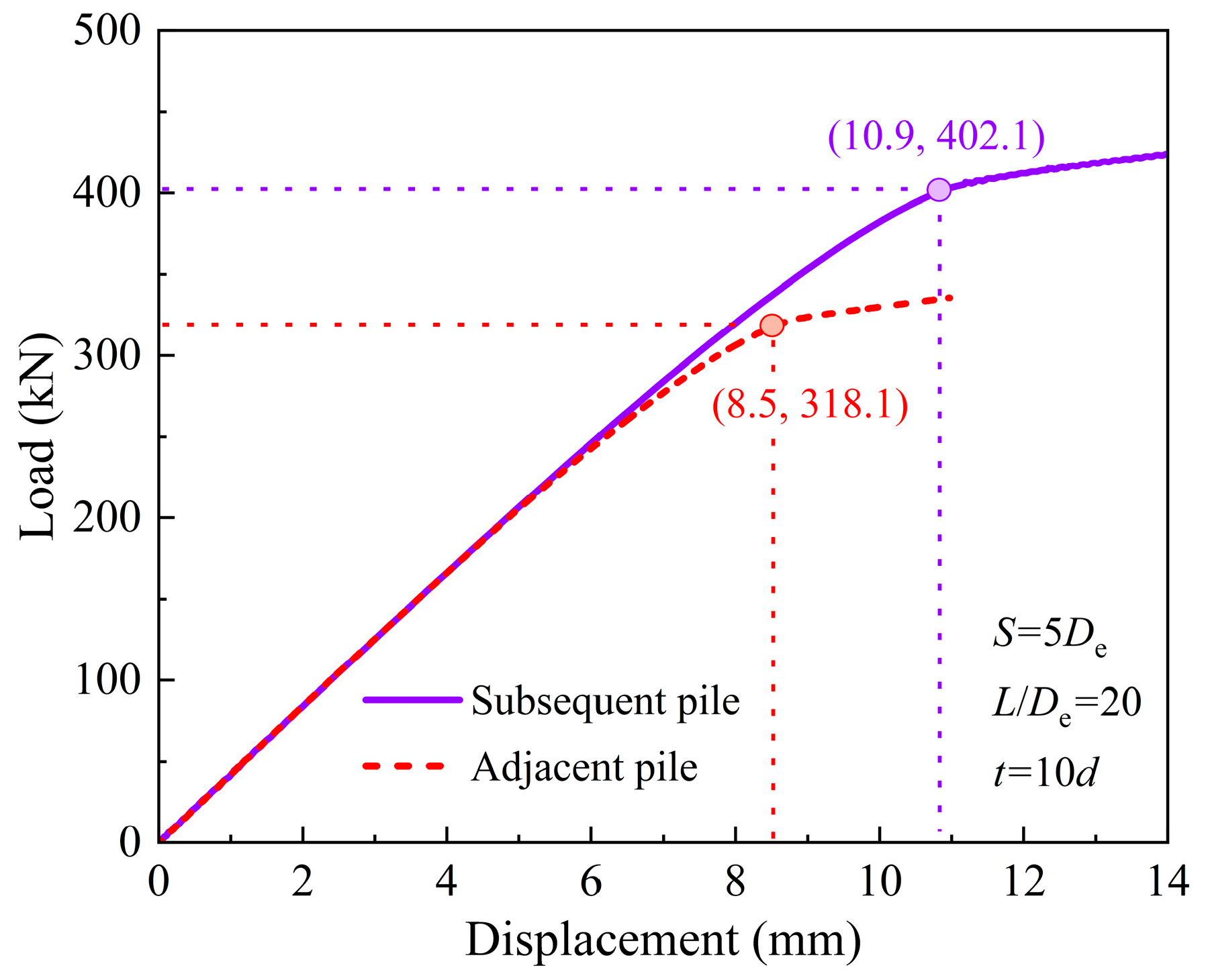
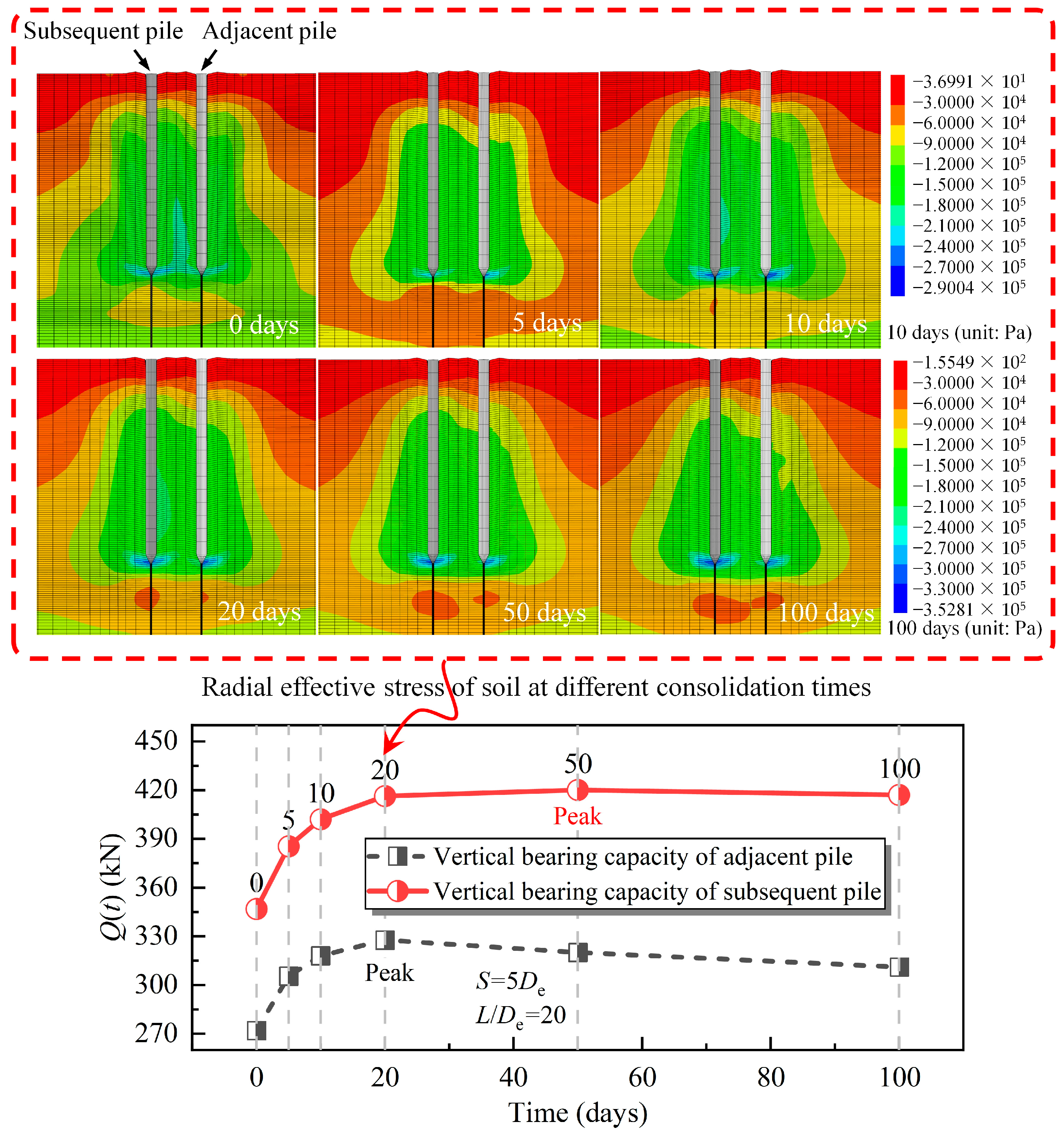
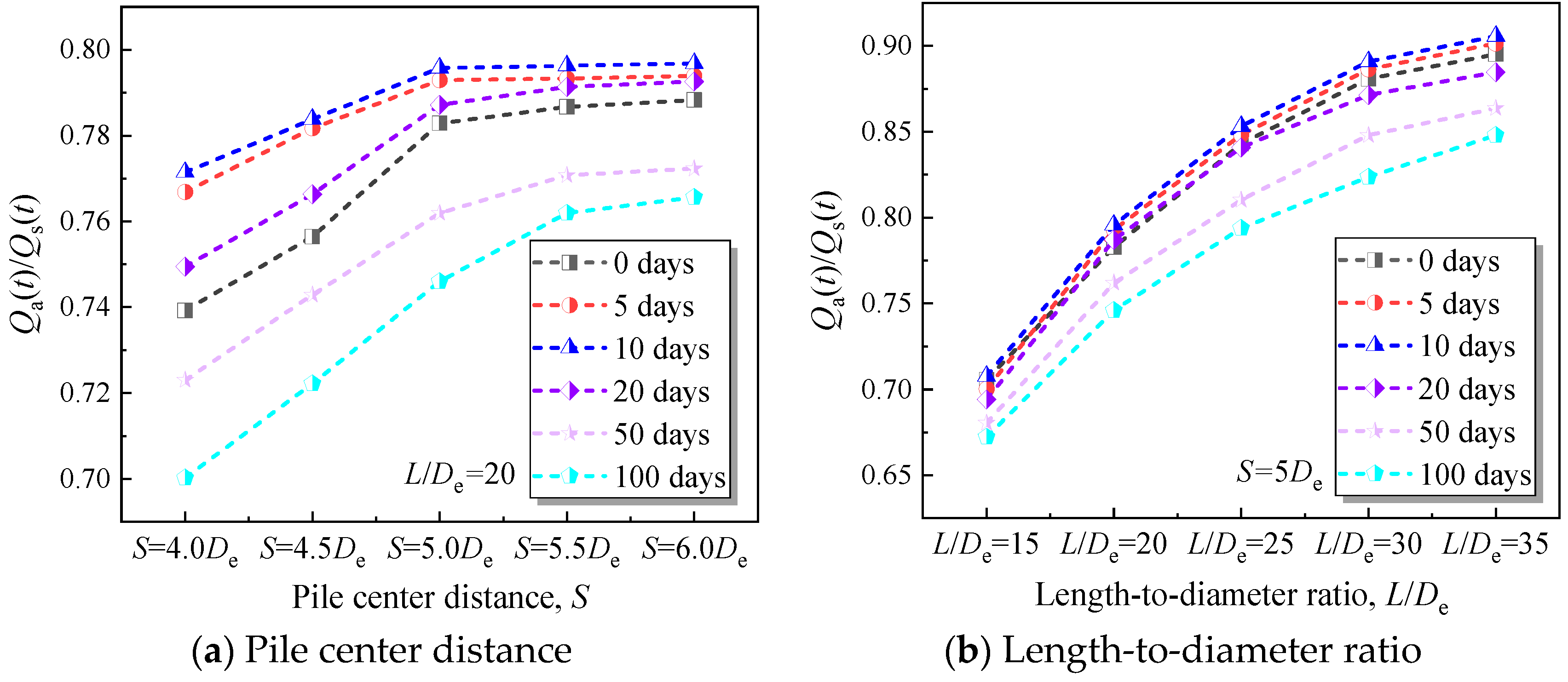
| Material | Saturated Clay | Pile |
|---|---|---|
| Constitutive model | Mohr–Coulomb | Linear elasticity |
| Elastic modulus [E/(GPa)] | 0.01 | 30 |
| Poisson’s ratio [v] | 0.45 | 0.27 |
| Density [ρ (kg/m3)] | 1800 | 2500 |
| Internal friction angle [φ/(°)] | 20 | — |
| Cohesion [c/(kPa)] | 15 | — |
| Earth pressure coefficient at rest [K0] | 0.5 | — |
| Contact Type | Frictional Contact |
|---|---|
| Normal stiffness [kn (Pa/m)] | 1 × 109 |
| Shear stiffness [kS (Pa/m)] | 1 × 109 |
| Contact surface cohesion [/(kPa)] | 4 |
| Contact surface friction angle [/(°)] | 8 |
| Fluid Type | Isotropic |
|---|---|
| Fluid bulk modulus [Kf/(Pa)] | 2 × 109 |
| Modified fluid bulk modulus [/(Pa)] | 1.5 × 106 |
| Permeability coefficient [k (cm/s)] | 1 × 10−7 |
| Fluid density [ρf (kg/m3)] | 1 × 103 |
| Fluid tensile strength [σf,t/(kPa)] | 10 |
| Porosity [P] | 0.5 |
| Main process calculation step [m] | 10 |
| Slave process calculation step [n] | 100 |
| Calculation Parameters | Values |
|---|---|
| Effective unit weight [γ′/(kN/m3)] | 8.75 |
| Effective internal friction angle [φ′/(°)] | 30 |
| Overconsolidation ratio [OCR] | 1.0 |
| Void ratio [e0] | 0.98 |
| Elastic modulus [E/(MPa)] | 24 |
| Poisson’s ratio [v] | 0.45 |
| Cohesion [c/(kPa)] | 15 |
| Earth pressure coefficient at rest [K0] | 0.55 |
| Coefficient of permeability [k/(cm/s)] | 2.65 × 10−7 |
Disclaimer/Publisher’s Note: The statements, opinions and data contained in all publications are solely those of the individual author(s) and contributor(s) and not of MDPI and/or the editor(s). MDPI and/or the editor(s) disclaim responsibility for any injury to people or property resulting from any ideas, methods, instructions or products referred to in the content. |
© 2024 by the authors. Licensee MDPI, Basel, Switzerland. This article is an open access article distributed under the terms and conditions of the Creative Commons Attribution (CC BY) license (https://creativecommons.org/licenses/by/4.0/).
Share and Cite
Xiong, W.; Li, Z.; Hu, D.; Li, F. Performance Analysis of Pile Group Installation in Saturated Clay. Appl. Sci. 2024, 14, 8321. https://doi.org/10.3390/app14188321
Xiong W, Li Z, Hu D, Li F. Performance Analysis of Pile Group Installation in Saturated Clay. Applied Sciences. 2024; 14(18):8321. https://doi.org/10.3390/app14188321
Chicago/Turabian StyleXiong, Wenlin, Zihang Li, Dan Hu, and Fen Li. 2024. "Performance Analysis of Pile Group Installation in Saturated Clay" Applied Sciences 14, no. 18: 8321. https://doi.org/10.3390/app14188321







